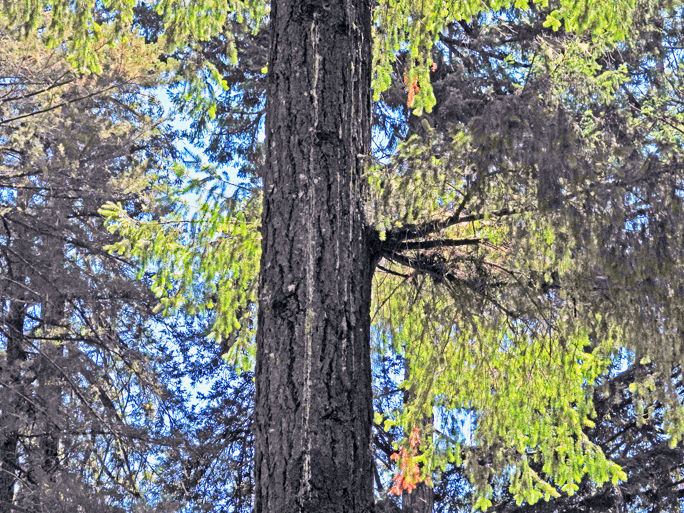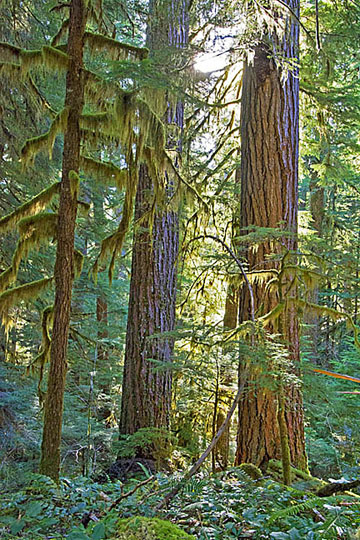| HOME | PROTECTION | NATURE | PLAN YOUR VISIT | FAQ | JOIN/DONATE | ABOUT |
| Douglas-fir |
Old-growth tree in the proposed Douglas-Fir
|
The Douglas-fir ecosystem supports not only the threatened northern spotted owl and one of its primary food sources—the red tree vole, but many other animals as well. Elk and black-tailed deer, porcupines, the Douglas squirrel and other mice and voles use the Douglas-fir as sustenance. Any number of birds eat the seeds of Douglas-fir, including song, white-crowned and golden-crowned sparrows, dark-eyed junco, pine siskin, purple finch and red crossbills. Black bears are known to hibernate in the rotted-out cavities at the base of older Doug-firs. Porcupines eat the inner bark of younger Douglas-firs; seeds are very important food for mice, voles, shrews and chipmunks; the Douglas ground squirrel caches cones for use throughout the winter.All of these birds and mammals and many more, use the Douglas-fir forest as a home during some or all of the year. What's in a name? The species is commonly named for another Scottish botanist, David Douglas, who sent some Douglas-fir seeds back to his motherland in 1827. The genus name translates to “false hemlock.” The Douglas-fir has been variously called the Douglas spruce, red-fir, Oregon-pine, and Columbia pine. Neither a spruce or a pine, it’s also not a “true fir” (Abies genus), despite its common name. (Don’t tell any English majors you know, but the hyphen in Douglas-fir was put there by botanists to signal it actually isn’t a true fir.) There are three recognized variants of Douglas-fir: • Coast (P. menziesii var. menziesii); “Glauca” is Latin for bluish-gray, blue, or blue-green. The Coast variant tends to be a darker green than the Rocky Mountain variant, which, of course, is somewhat blusish. There is also a “bigcone Douglas-fir”, but it's a different species (P. marcrocarpa) found in the mountains of southern California. It is also known locally as bigcone spruce though, of course, it's not a real spruce species.
Identifying a Douglas-fir |
 |
| One of the fun features of the coastal Douglas-fir is that it occasionally grows a sort of a natural shelf in the understory. The shelf-like growth (an unscientific label) is composed of a single eruption, that usually looks like several branches all growing from the same spot. This growth is a great place for the Northern Spotted Owl to roost and nest. It is sometimes used as an indicator of prime Spotted Owl habitat. |
 |
| Have fun in the forest Once you become known as an advocate of the Douglas-Fir National Monument, you will want to go for more hikes in the woods of the proposed Monument. My advice to you as a fellow advocate of the Douglas-Fir National Monument is, when you go for a hike in the woods, you need to be ready when someone asks you: “What kind of a tree is that?” You will feel pressure to appear knowledgeable, so if all the trees around you look alike, you should look at the tree carefully and say: ’Well, of course I am no David Douglas (the world-famous botanist for whom the tree is named), but that tree looks like a Douglas-fir to me.” If it is a really large tree with rough brown bark, then add, with confidence: “Isn’t it magnificent?” If you adopt this strategy, you are, by the law of averages, likely to be right, and you will solidify your reputation as a real tree nerd. (I follow the same strategy with “identifying” red-tailed hawks). There are other trees in the Douglas-fir ecosystem, so you won’t always be right, but you will probably average better than sixty to seventy-five percent, and, as long as you are not hiking with a real botanist, you can probably get away with it. |
 |
 Photo curtesey of Chandra LaGue |
You can study the features of some of the other more common trees at Other Conifers page. Read more on the Old-growth Forests Page We want to create a Douglas-Fir National Monument to recognize and preserve the unique ecosystem that is a Douglas-fir forest. The Douglas-fir ecosystem is a scientific wonder, supporting unique species and common species in a unique way. The proposed Douglas-Fir National Monument contains stretches of Douglas-fir forests of all ages, large areas of mature forests and numerous small stands of old-growth forests. The mission of the Friends is to recognize the scientific, cultural and historic character of the ecosystem, and to restore a significant area to the fully natural functioning forest it once was. |
| Return to Nature |